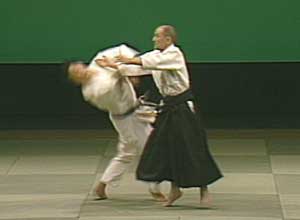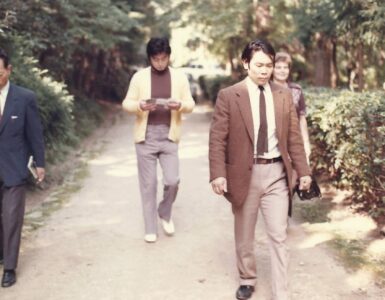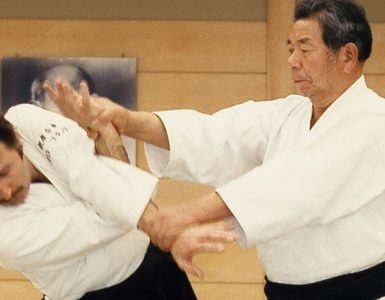The following translation from the Japanese-language autobiography entitled Aikido Jinsei (An Aikido Life) by Gozo Shioda Sensei of Yoshinkan Aikido is published with the kind permission of the author and the publisher, Takeuchi Shoten Shinsha. This series of installments began with AIKI NEWS No. 72. Read the fourth part here.
Chapter 7: Practice
Of course it is important to conduct aikido training in a dojo where you accumulate practice time in order to master techniques. There is a saying of Sogen Zenshi (priest of the Rinsaishu religion of the late Kamakura Period) which is as follows: “The time spent engaged in the four cardinal actions—walking, stopping, sitting and lying—is the best dojo.” I consider these words as my motto and am always trying to keep them in mind. I hope at least those who practice aikido will try to do the same and that they will think of any situation such as walking, riding on a train or eating, as their aikido dojo where every little thing is a part of their practice.
For example, if there is a goldfish tank, instead of just watching the goldfish swim, you can lightly tap the glass to see how the surprised fish move at that moment or see how they avoid running into each other even where there are many in the tank.
Or you can place a stick on the top of a door and set it in such a position that every time the door is opened it falls. In this way you can practice how to avoid the stick as part of your training. Walking smoothly without crashing into people in a crowd is training too.
When I was an uchideshi of Ueshiba Sensei I would wash his back whenever he took a bath. What I kept in mind to do was to learn the knack of reading his mind as quickly as possible and act accordingly. For instance, when Sensei was going to wash his hair, I would immediately bring him a pail of hot water. I waited until he finished washing his hair and would time my action of pouring hot water over his head. While doing this, I had to think what would be the best way of pouring the hot water in order to satisfy him. To exaggerate somewhat, I was learning the art of “ahum” or inspiration and expiration. Also when I washed his back I observed the movements of his muscles. This too was certainly good training for me.
After Master Ueshiba died, I practiced with dogs as my masters. I have liked animals, especially dogs, since my childhood and have always kept one. I loved a Shikoku dog whose name was “Ryu” in particular. Ryu had a very sharp temper and never let anyone other than me near him. When I got up at five o’clock every morning I took him to Shakujii Park and let him loose while no one was around. Then I did things to make him angry. When he started to feel uncomfortable—after all he was an animal—he came to attack me with his fangs bared. The battle between Ryu and me would begin. He would come at me and I would dodge his attack. Then he would attack me again. In the beginning, when we repeated this I would have wounds all over my hands, arms, body and legs. When I shouted, “Stop!” since he was a clever dog, he stopped attacking me with a triumphant look on his face. I engaged in this kind of battle with Ryu every day and gradually I stopped getting hurt. This is dangerous and I would not recommend that you imitate me but when Ryu died I felt a sadness as though I had lost a master.
Anyway, those who try to master aikido should always keep in mind that there are places everywhere to practice and try to use any opportunity for training.
Moreover, you should never lose a sense of humility as a practitioner even in the presence of a beginner. Imagine that a beginner enters the dojo. This person, of course, doesn’t know anything about aikido, which means he is completely pure. Since he is pure he may have some good points which you don’t have or you may realize your bad points through him. Therefore, a sense of humility where you consider a person who enters your dojo for the first time as your instructor is required.
In 1963, although I have forgotten the exact date, a certain Shorinji Kempo sensei named Shin Sode visited my dojo in Tsukudo Hachiman in formal Japanese dress and requested to see me demonstrate techniques. I welcomed him politely and demonstrated techniques using my students. After that he said: “Since I have often heard of you, Shioda Sensei, I wished very much to see you and have come today. Your performance was really impressive and exceeded my expectations. I would like to draw upon what I have seen in my own practice.” I felt very flattered. I think that the reason he took the trouble to dress formally is because he had a great regard for etiquette. Although he was a large person, he didn’t have a boastful air and his attitude was always modest. Seeing his manner I was really impressed and thought that an expert is really different. Unfortunately, Shin Sodo Sensei has passed away and I would like to express my sincere regrets over his death.
Chapter 8: Heartfelt Gratitude
I am the kind of person who did everything I pleased when I was a youth. Therefore, I try never to forget the kindness of those who have warmheartedly helped and supported me. My life today is complete thanks to these people. There have been innumerable persons like that and I really think that I am a fortunate man.
Of course it is important to conduct aikido training in a dojo where you accumulate practice time in order to master techniques. There is a saying of Sogen Zenshi (priest of the Rinsaishu religion of the late Kamakura Period) which is as follows: “The time spent engaged in the four cardinal actions—walking, stopping, sitting and lying—is the best dojo.” I consider these words as my motto and am always trying to keep them in mind. I hope at least those who practice aikido will try to do the same and that they will think of any situation such as walking, riding on a train or eating, as their aikido dojo where every little thing is a part of their practice.
Since I will mention those to whom I have been indebted before, during and after the war in Part II, I would like to omit mentioning their names here.
However, I must express my gratitude especially to my father, Seiichi Shioda and Mr. Munetaka Abe, headmaster of Dairoku Junior High School who recommended that I set out on the path of aikido. As a lifelong practitioner of aikido, I would like to continue to live up to the words my father imparted to me: “Justice leads to victory in the end,” and “A proud moment is the most dangerous.”
The next person to whom I must express my gratitude is, naturally, Morihei Ueshiba Sensei of aikido. Since I talk about the greatness of Sensei here and there I would like to avoid repeating myself but it is thanks to him that I am now able to earn my livelihood through aikido. His teachings for some eight years starting in May 1932 when I first entered the dojo through March 1941 when I left the dojo and the period I spent with him after the war still are etched vividly in my memory.
There are people I do not mention in Part II and I would like to express my gratitude to them here. One of them is Mr. Ryoichi Sasagawa, chairman of the Japan Motor boat Promotion Association. Mr. Sasagawa is a person who thinks much of propriety and starting around November 1963, he entrusted us with the instruction of aikido to motor boat racers as well as employees of the Motosu Training Center in order to have them learn propriety. We continue to instruct them today. Also, when we built the Koganei Hombu Dojo he made a generous donation and further, supports us financially by contributing a part of our dojo operating capital. I cannot explain in words how helpful this is in the operation of a modest martial art dojo.
The other person I would like to mention here is Mr. Katsuei Mori Sensei who is 95 years old (1985). He worked as a captain in the Osaka Merchant Marine for many years and is a benefactor of Mr. Laurens Van Der Post (author of “Merry Christmas, Mr. Lawrence,” made into a film directed by Nagisa Oshima). He is also a master of kendo. This Sensei is still vigorous in his old age and recognizes aikido as the best martial art and supports me publicly and privately. I feel appreciative of him and am stimulated to work harder since I am still just an upstart compared to him.
Moreover, you should never lose a sense of humility as a practitioner even in the presence of a beginner. Imagine that a beginner enters the dojo. This person, of course, doesn’t know anything about aikido, which means he is completely pure. Since he is pure he may have some good points which you don’t have or you may realize your bad points through him. Therefore, a sense of humility where you consider a person who enters your dojo for the first time as your instructor is required.
Those who embark on the aikido path should devote themselves to practice all of their lives with pure and modest hearts without forgetting a feeling of gratitude towards all things. In the Analects of Confucius there is the following saying: “The good will not long remain lonely.” There may be only a few people who are perfect but if you try to cultivate virtue, those who have the same goals will gather around you. I would be appreciative if you would consider this as a part of your training in aikido, the martial art of harmony.
Chapter 9: Aikido Is An Art To Be Enjoyed
It is natural that great effort is required in practice in order to become an expert in any martial art, not only aikido. However, an equanimity of spirit which allows you to transform the hardships of training into enjoyment is necessary. It is similar to your not being able to display your power if you push yourself too hard. If you think you are suffering you lose body flexibility and start to feel down. Paradoxically, if you think you are enjoying yourself your suffering will disappear. The more you become serious the more you feel agony but if you try with a happy heart, practice must become enjoyable.
Needless to say, aikido is not only for experts.
I believe that those who wish to practice aikido to improve their health, to eliminate stress or to gain confidence by attaining a certain degree of mastery can achieve their goal if they try to learn the art with a beginner’s mind and study basic technique. Since aikido is a physical art where importance is attached to the spirit, your spiritual and physical sides will become well-balanced. Therefore, you will be able to develop true health and indeed be able to rid yourself of stress, enjoy a healthy mind and be confident.
Since there are no matches in aikido, you don’t have to be happy one minute and sad the next over winning or losing. Also since there are no violent clashing movements, even children, women and elderly persons can begin aikido anytime. You don’t need to hurry. All you do is just engage in regular practice one session at a time. The pleasure of aikido lies in the fact that everyone can have their own way of training. Therein lies the secret of improvement in techniques.
While engaging in regular practice with a pure mind you naturally acquire skill in self-defense techniques. Although Japan as a nation is most noted for peace and public order, you cannot say that you will never encounter a situation where you feel danger. Major happenings like murders and bank robberies become news but there are instances where people face serious danger even if it doesn’t reach the newspapers. There are some members of our dojo who have narrowly escaped from such situations. For example, many women have been attacked by molesters. One woman repelled a molester with only several months of training experience and one succeeded in stopping an assailant and took him to the police. When a taxi driver was choked from behind by a car thief with a net, he broke the strong net with his hands, something which one would never be able to do in a normal situation. He then proceeded to catch the culprit and hand him over to the police. There are also a couple of cases of one man using the ukemi falling technique he learned the moment he was touched by a car on the road thus escaping injury.
Those who embark on the aikido path should devote themselves to practice all of their lives with pure and modest hearts without forgetting a feeling of gratitude towards all things. In the Analects of Confucius there is the following saying: “The good will not long remain lonely.” There may be only a few people who are perfect but if you try to cultivate virtue, those who have the same goals will gather around you. I would be appreciative if you would consider this as a part of your training in aikido, the martial art of harmony.
Even just taking falls can be very effective. The Himawari Kindergarten located in Kawagoe and Soka City in Saitama Prefecture had their children learn aikido and suddenly the cases of injury or accidents involving children began to decline. Apparently the doctor in charge was very surprised at this.
In another instance, a man who had a leg problem due to infantile paralysis was able to devote himself to regular practice. Although in the beginning his legs often bled from coming into contact with the mat and the instructors used to find it very painful to watch, his efforts were rewarded and he became able to walk almost like a normal person.
While continuing to practice aikido, you become able to move quickly without realizing it and also become capable of displaying unexpected power in your techniques.
It is said that in budo you start and end with courtesy. The Yoshinkan also respects courtesy and practices it during instruction. Thus young people gradually become well-behaved and their parents are pleased.
In the Yoshinkan there are no rules. I believe that in aikido we should not control people with rules but should consider the importance of individual viewpoints. Things you realize yourself are the most meaningful and influence you over the long term. As long as you enjoy practice in the company of cheerful people and maintain a harmonious relationship with them, you will naturally integrate yourself into the dojo atmosphere and learn the invisible rules. Those who enter the dojo with an evil heart in an effort to use aikido as a means of fighting always drop out. Those who stay are people who reflect on their own conduct. This has been proven over and over again.
Although I am being repetitious, the Yoshinkan exists as a dojo where people can always practice cheerfully and enjoyably in harmony.













Add comment